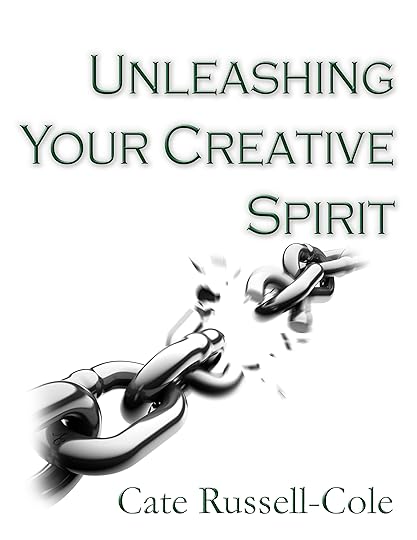Cate Russell-Cole's Blog, page 53
September 24, 2012
Apology on Comment Removal
 Hi everyone, as much as I love feedback, due to a flood of spam, it’s become necessary to turn off all comments on posts in order to balance my workload. I’m being flooded!
Hi everyone, as much as I love feedback, due to a flood of spam, it’s become necessary to turn off all comments on posts in order to balance my workload. I’m being flooded!
The blog is copping up to 30 comments needing moderation a day. It’s an insane time waster, as there are genuine people buried in all that I don’t want to snub!
I would still very much like to hear from you. All my blog posts are on Twitter and Google Plus (links are on the right of this page), where comments are less prone to abuse… plus you have the benefit of the other writing resources I frequently share.
Please liberally use the Like button instead. Again, I am very sorry to be so anti-social. If anyone decides to start a “shoot a spammer” day, I’m in!
Cate

September 20, 2012
Channelling Creative Ecstasy Into Word Counts
“What percentage of your time should you spend thinking about writing, as opposed to the percentage of time you should spend building your word count?”
What’s your opinion on this question as a writer? Which should be greater? Writing or planning? Or is this a chicken and the egg question?

Image taken from the “Louisa May Alcott is My Passion” blog. Please click on the image to visit the blog. I presume the photo comes from a movie, I am unaware of which one.
Thinking, day dreaming, reading others’ work and mentally planning are critical parts of the creative process, yet we don’t necessarily count them as productive time. Too often we let activity, goals, self-imposed deadlines and social media “shoulds” hijack our creative lives. Then our joy in writing drains away and we wonder why.
Solitude has always been a necessary part of many writer’s routines. My first introduction to the writing life came from reading “Little Women” as a child. “Her `scribbling suit’ consisted of a black woolen pinafore on which she could wipe her pen at will, and a cap of the same material, adorned with a cheerful red bow, into which she bundled her hair when the decks were cleared for action. This cap was a beacon to the inquiring eyes of her family, who during these periods kept their distance, merely popping in their heads semi-occasionally to ask, with interest, “Does genius burn, Jo?”
To be honest, I don’t welcome those sort of interruptions. When I am writing, studying or reading, I need to be left alone. Having to stop and start a train of thought irritates me. The image of a writer slaving away alone in the attic is much more me. At times, I just need to sit still and think. I am not writing, planning blog posts, Twitter promos, worrying about e-book sagas or any of that. I just need to be. That is when I get back in touch with my true creative self and from that I can produce good work. Staring at the to-do list merely robs me.
If you read the work of creativity researcher Mihaly Csikszentmihalyi, you will discover that being alone and being able to get away from the outside world and inside yourself, produces a state of focus and concentration which induces creative flow. We need that flow. It takes the drudge work out of the process and breathes enthusiasm into us. Mihaly talks about a state of ecstasy which we can gain from creativity. To gain that, we must spend some time alone. (If you click on the red link, it will take you to a TED talks video which explores this concept more.)

This badge is available from www.wanelo.com Image found on Pinterest.
Getting away from it all is not a new concept. Many world religions encourage pilgrimages and have legendary tales about going into the wilderness to grapple with their issues; then coming out refreshed, inspired and with far more to offer those around them than when they went in.
While setting word goals can be important, never underestimate the power of being inside your own mind, building your characters and experiencing your story as if you were a part of it. Fantasy, asking “what if” questions and playing with ideas are integral to the writing process.
While we need writers communities and initiatives for encouragement; plus the time to promote ourselves through social media; every so often it’s good to be reminded that we don’t have to be constantly in each other’s faces or typing, typing, typing to be achieving! So occasionally, unplug the Internet, get away from all temptations and sit, walk or run away to be by yourself for awhile. Your writing will be far better for it.
This article is Copyright Cate Russell-Cole 2012. It may not be reproduced in any form, without my prior written permission. All rights reserved.
Filed under: Creativity, Food For Thought, Inspiration, Writer's Recovery Community Post, Writing Tagged: author, creative ecstasy, creativity, discovery, flow, ideas, inspiration, Little Women, Mihaly Csikszentmihalyi, motivation, passion, quiet, resource, social media, solitude, subconscious, TED Talks, thinking, Twitter, writer, writing

September 17, 2012
Criticism on Criticism: What it Takes
 Several weeks ago I published a blog post which was about dealing with criticism. On Twitter, several people commented that you shouldn’t be a writer if you couldn’t handle criticism. I ignored them. I can understand that if you came up through a competitive world, such as journalism, you have to be tougher than granite to survive. However, I thought they lacked compassion for their fellow wordsmiths. Just because someone isn’t an emotional Rambo, doesn’t mean they should abandon their gift of writing. That’s just a waste!
Several weeks ago I published a blog post which was about dealing with criticism. On Twitter, several people commented that you shouldn’t be a writer if you couldn’t handle criticism. I ignored them. I can understand that if you came up through a competitive world, such as journalism, you have to be tougher than granite to survive. However, I thought they lacked compassion for their fellow wordsmiths. Just because someone isn’t an emotional Rambo, doesn’t mean they should abandon their gift of writing. That’s just a waste!
Everyone starts at a place of insecurity: whether they later choose to remember that or not. What matters most is persistence, dedication and using what courage you can muster up, to continue to grow creatively. Too many people give up when discouragement and fear hit. Being able to move ahead despite threats or setbacks, is the bravest move. I hope you continue to keep writing, regardless of what challenges lie ahead of you.
By the way, if there is a Twitter log in which is unkind_intolerance I am not aware of it and not referring to them. I simply wanted an image of a Twitter block button so I photoshopped a screenshot. That’s why the name is blue. It’s not meant to exist.
Filed under: Blogging, Creativity, Food For Thought, Indie Publishing, Writer's Recovery Community Post, Writing Tagged: blog, bravery, criticism, dedication, gift, giving up, persistence, writer, writing

September 13, 2012
Why Characters Will Change Their Lives… Or Won’t!
 I was reading a great post by a ROW80 blogger who was talking about setting a goal to write 1000 words every Thursday. She was going to title it “100 word Thursday.” It made me stop and laugh at myself. When I was in Senior High School, all our essays were 1000 words and I submitted at least 2-3 a week. I notice that even, um, x years later, I still write 1000 word blog posts, or close to it! I have been brain-washed and have a dreadful time trying to keep my posts to the obligatory 600 words. Often, I don’t even try… I know myself too well.
I was reading a great post by a ROW80 blogger who was talking about setting a goal to write 1000 words every Thursday. She was going to title it “100 word Thursday.” It made me stop and laugh at myself. When I was in Senior High School, all our essays were 1000 words and I submitted at least 2-3 a week. I notice that even, um, x years later, I still write 1000 word blog posts, or close to it! I have been brain-washed and have a dreadful time trying to keep my posts to the obligatory 600 words. Often, I don’t even try… I know myself too well.
This is a simple idea I want to share with you today, so in the interests of making up for all my previous excess wordiness on posts, here it is…
Many people will only make lasting, effective changes in their lives, when the pain of staying the way they are becomes too much.
Think about it. How much unfulfilled diets, exercise regimes, job changes, relationship promises and new year’s resolutions are out there? Because unless we are self motivated, staying where we are is just too comfy. We don’t move until it hurts, or we’re backed into a corner. It’s one of the most basic principles of human behaviour, but hard to recognise. You’ve heard the term, “they need to have a bomb put under them?” It moves people as it will hurt, right?
Have an excellent writing week!

The photo in this post are paid for and licenced to me. They are Copywritten. You may not save them or use them for your own purposes. You can purchase them from iStockphoto.com This article is Copyright Cate Russell-Cole 2012. It may only be reproduced, with my permission, for non commercial purposes only. My name and Copyright must remain intact. For permission, please email me at: cate@virtual-desk.com.au
Filed under: Blogging, Creativity, Fiction and Characterisation, Food For Thought, Indie Publishing, Inspiration, Writing Tagged: behaviour, change, characters, failures, motivation, pain, plans, plot, psychology, resolutions, story, unfulfilled, writer, writing

September 10, 2012
I Haven’t Forgotten
Twice a week I write a blog post which come out on specific days. I have a lot of commitments on my shoulders, so I stick to routine to get everything done. Late August I wrote the one for today, then I looked at the date and cringed. Even from Australia a decade later, I still cannot forget the horror of 9/11 and just cannot put out a post about pain, change and include the word bomb. This has nothing to do with politics, who is right or wrong or any of that mess. This is about the people who have been affected and the impact it had on the world.

Filed under: Personal Post

September 6, 2012
Expanding Your Mind Map Horizons
The best writer’s technique I teach is mind mapping. For pulling ideas out of thin air, reclaiming memories and discovering new directions, it’s unbeatable. Corporations and organisations around the world use this technique in product development and problem solving. Boeing once produced a mind map so large, it spread right around the walls of the conference room. Every time I do this exercise with a class, they are amazed at the ideas which come out of nowhere.
A mind map for a young adult fiction paranormal story may look like this:

From www.mindmapinspiration.com
They have great ideas well worth checking out.
Simply explained, you write down your topic in the middle of a blank page, and then you write down whatever words come to mind that relate to that topic. These are linked to the main topic by a line. From there, you can radiate out from the topic, by writing down what you associate with these words, until you cannot come up with any more. You can do whatever you want, as long as the progression of ideas is easy to follow and all your ideas are allowed to flow freely without evaluating them as they come. Later you can keep the ideas that are good, and set the rest aside. You may be able to adapt them later.
I’ve spent so long teaching mind mapping for idea production that it took me awhile to realise it has a further use: organisation and planning. It’s an excellent way of pulling together all those strands of what needs to be done and determining where you’re going. Once things start to become complex, such as my web site, it works as a great visual reference that pulls all the pieces together. For example, at the end of last year I did a planning mind map for my web site which turned out like this:
I found the use of logos helped me quickly identify where each piece of my marketing strategy belonged. Colours also made it so much easier to read.
So when you’re setting goals, plotting chapters, linking up character relationships, working out tasks that need doing, or whatever else needs to be done, try a mind map. There are many great pieces of software for mobile devices and computers which will assist you. For more information, try Buzan’s mind map web site. He has a special interest in creativity. http://blog.thinkbuzan.com/
Filed under: Blogging, Creativity, Fiction and Characterisation, Indie Publishing, Inspiration, Resources, Writing Tagged: Buzan, creativity, discovery, goals, ideas, mind map, organisation, organization, planning, problem solving, productivity, resource, subconscious, thinking, writer, writing

September 3, 2012
Terry Pratchett “The Importance of Being Amazed about Absolutely Everything”
If you have ever wondered where Terry Pratchett’s fertile mind got it’s ideas from, this is the video for you. Terry gets his PA to do the speech as he is very unwell at the time (2010). It is very funny… A great overview of Terry’s background, love of books and stories; and his views on life. It’s a gem for all Pratchett fans. I was glued to it. I can see where his ideas came from.
As he says, he “absorbed writers and was astonished at the wealth laid out” for him. It was “better than writing tips.” Terry has since responded to a question on how to write by saying, don’t listen to me, just go and do it.
The link is set to start at 11 minutes and miss the obligatory “thanks to everyone who made this possible speech.” It was Terry’s first speech as Professor at Trinity College, Dublin.

Bio from his web site: “Terry Pratchett is the acclaimed creator of the global bestselling Discworld series, the first of which, The Colour of Magic, was published in 1983. In all, he is the author of fifty bestselling books. His novels have been widely adapted for stage and screen, and he is the winner of multiple prizes, including the Carnegie Medal, as well as being awarded a knighthood for services to literature. Worldwide sales of his books now stand at 70 million, and they have been translated into thirty-seven languages.”
Filed under: Creativity, Food For Thought, Inspiration, Writing Tagged: author, biography, creativity, curiosity, discovery, education, fantasy, ideas, inspiration, learning, passion, science fiction, study, Terry Pratchett, Trinity College Dublin, writer, writing

August 30, 2012
Handling Criticism As A Writer
 One of the greatest problems creative people have had, is that really good ideas don’t always receive the reception they deserve. You will always come up against the grouches who wouldn’t do it that way, or think your ideas stink! Never mind the critics. They are thoroughly capable of being completely wrong! Do you think the authors of great novels were told any differently? Can you imagine what some people would have said to Suzanne Collins when she told them her idea for The Hunger Games?
One of the greatest problems creative people have had, is that really good ideas don’t always receive the reception they deserve. You will always come up against the grouches who wouldn’t do it that way, or think your ideas stink! Never mind the critics. They are thoroughly capable of being completely wrong! Do you think the authors of great novels were told any differently? Can you imagine what some people would have said to Suzanne Collins when she told them her idea for The Hunger Games?
Here are suggestions on handling criticism.
Learn how to handle it, as some of it is useful. You can’t see your blind spots or where you need to grow, others can and an honest and well meant piece of criticism can be valuable.
Stubbornness and being fiercely protective of your work can come from fear and low self esteem (self doubts). Work on overcoming this.
“All creative work is a constant process of learning.” That process will involve mistakes, and sometimes others will pick up the mistakes you haven’t noticed. It’s up to you whether to see that as being good or bad.
This old post is an excerpt from Cate’s e-book “Unleashing Your Creative Spirit” which has just been officially released. If you have an interest in enhancing your creative potential, the e-book will be of inspiration to you.
Unleashing Your Creative Spirit was written to help you turn your dreams into reality! It explores the process and practical aspects of creativity; and has been written for artists, writers, musicians, dancers, gardeners, cooks, craft lovers: anyone trying to tap into their creative potential. It looks at the mental processing behind creativity; philosophies that drive how we think about and assess our creative worth; creative character traits; historical role models; an extensive bibliography and web link list plus more. The content is practical, not just analytical. It will give you ideas on how to move forward in your creative life.
Capturing the Muse
Quieting the Internal Censor
Building A Creative Space
Working With Failure
Finding Direction
Techniques To Use
The abridged ebook is available now on Amazon Kindle. The full illustrated e-course version with additional resources and exercises is only available from me, as e-book formats cannot handle it. You can order it directly from http://www.virtual-desk.com.au/trainer.html. Please scroll down the the course list and the select the buy button.
This article is Copyright Cate Russell-Cole 2012. All rights reserved. It may not be reproduced in any medium, in print or digital format.
Filed under: Creativity, Food For Thought, Indie Publishing, Inspiration, Resources, Writer's Recovery Community Post, Writing Tagged: creativity, criticism, failure, goals, inventors, motivation, passion, perseverance, problem solving, success, The Hunger Games, writer, writing

August 27, 2012
Live Where You Don’t Exist
 As writers we spend a lot of time in worlds that don’t exist. If you are trying to write about a lifestyle which is outside your experience, it can be hard to get the details right. Or if you are a writer who prefers to focus more on plot and character development than people and place descriptions, coming up with outfits, physical appearances, landscapes etc. can be annoying! However, the best writing engages all the five senses in a reader: what places and people look like; what smells are dominant and move the story forward; textures such as fabric or furniture (touch); the taste of food and sounds which are relevant to the storyline.
As writers we spend a lot of time in worlds that don’t exist. If you are trying to write about a lifestyle which is outside your experience, it can be hard to get the details right. Or if you are a writer who prefers to focus more on plot and character development than people and place descriptions, coming up with outfits, physical appearances, landscapes etc. can be annoying! However, the best writing engages all the five senses in a reader: what places and people look like; what smells are dominant and move the story forward; textures such as fabric or furniture (touch); the taste of food and sounds which are relevant to the storyline.
You may find it helpful to treat your writing like a movie set. Consider what features, objects and looks will harmonise with what you need to communicate about the character’s personality, state of mind, living or working space, economic lifestyle or neighbourhood.
 To do that you have several options.
To do that you have several options.
You can research. Make sure you have your facts straight, particularly if you are writing about a different time period or country. Don’t just look at the words though, look at as many photos and illustrations as you can. Check historical almanacs, coffee table books and anything you can get your hands on from other periods in time to get hold of details.
Start a file for each book or character, particularly if you are having issues getting it all straight in your head! It doesn’t have to be big.
Sketch out the floor plans of offices, workplaces, homes, restaurants where key events happen etc.
Go somewhere and take notes about the decor and furnishings. In an awkward silence in a meal you can have a character notice that flaking paint in a fancy restaurant. Stories you can picture are always the best!
Read through house and garden magazines and find ideal home styles, rooms and gardens which you can use or adapt.
Build a file of fashion magazines including various budgets. Also use them for describing character’s facial features, hairstyles and other aspects of physical appearance. Magazines which feature real people’s stories and photos are ideal for this, as they remove the photoshopped false perfection. When I wrote the Chronicles of Mirchar, I had a picture of every character taken from a magazine so I could build in variety and individualism.
Sketching out details such as these can also save you editing work later. For example, it helps in picking up inconsistencies, such as the fact that the poison hidden in the cupboard above the fridge, is suddenly hidden next to the dishwasher two chapters later… Oops! A quick kitchen plan can help you iron out what is where, plot how events happen and give you that gem every writer needs… even more ideas. If they trip over the mat… then land next to the glass cabinet… then they will see that half-hidden photo which causes all hell to break loose!
If you can picture it, you will know how to write it!

This article is Copyright Cate Russell-Cole 2012. It may not be reproduced in any form, without my prior written permission. All rights reserved. Images from this post were built using Chief Architect’s Home Design Software eons ago and may be reproduced without breaking copyright.
 If you are interested in adding more depth to your writing, you may find Creating and Resolving Conflicts In Fiction helpful. This book dissects conflict into it’s component parts; looks at how it works and helps you generate conflict plot-lines and themes which will add richness and realism to your work. The principles apply to any kind of fiction, regardless of the length, characters or genre. It is written by a writing teacher who also has a background in counselling.
If you are interested in adding more depth to your writing, you may find Creating and Resolving Conflicts In Fiction helpful. This book dissects conflict into it’s component parts; looks at how it works and helps you generate conflict plot-lines and themes which will add richness and realism to your work. The principles apply to any kind of fiction, regardless of the length, characters or genre. It is written by a writing teacher who also has a background in counselling.
Creating and Resolving Conflict in Fiction is the first book in the Four Dimensional Characterisation Series. The series has been written to give writers an insight into the aspects of psychology that are the most invaluable for fiction writers. It will assist you in creating personality traits and behaviour patterns which make your characters realistic, unique and believable. This book in the series is focussed on conflict in any kind of relationship.
Filed under: Creativity, Fiction and Characterisation, Food For Thought, Indie Publishing, Writing Tagged: author, books, challenge, characterisation, creativity, description, details, fiction, five senses, ideas, inspiration, originality, research, set, setting, stage set, success, writer, writing

August 23, 2012
Editing Checklists and Resources for Writers
 I love writing. I hate editing. I don’t know anyone who doesn’t feel the same. To attempt to untangle my piles of letters and punctuation into some kind of order, I put together an editing checklist. As I am an article writer, it is predominantly aimed at that work. However, you are welcome to take the concept and adapt it to your needs as you see fit. There are no copyright concerns.
I love writing. I hate editing. I don’t know anyone who doesn’t feel the same. To attempt to untangle my piles of letters and punctuation into some kind of order, I put together an editing checklist. As I am an article writer, it is predominantly aimed at that work. However, you are welcome to take the concept and adapt it to your needs as you see fit. There are no copyright concerns.
For a list of editing symbols which you can use to mark up printed copies of your work, please visit these web sites:
Merriam Webster: http://webster.commnet.edu/writing/symbols.htm
Wadsworth: http://tinyurl.com/5gu6v8
I have found that I don’t always see mistakes on the computer screen, but if I print my work out, then the mistakes become visible. Leave yourself a two inch margin on the left hand side and double space your work so you can write in revisions.
Formal Reference Sources
If you need further help, can I recommend two sources. The first is the Elements of Style by William Strunk Jnr. I know it’s not riveting reading, but it keeps you on track. You can get the full text online at: http://www.bartleby.com/141/
 My other suggestion is to find a style guide you like and stick to it! Organisations I have worked for had particular style guides, which were developed by a local University. Style guides set specific rules on points such as how numbers are presented; whether you type e-mail or email and if you do or do not place a comma after the word ‘and’ (which in case you were wondering, I don’t do, as the style guides have me firmly on track.) Those rules are adhered to for all writing. There is no variance in approach, whatever the project: you know where you stand! If you are in the United States, The Harvard Style Guide is here: http://www.swinburne.edu.au/lib/researchhelp/harvard_style.html there is also an excellent one at Wadsworth.com, which is where the tiny url link to editing symbols came from. It’s comprehensive! http://wadsworth.com/english_d/templates/student_resources/1413001890_burnett/UsageHandbook/index.htm
My other suggestion is to find a style guide you like and stick to it! Organisations I have worked for had particular style guides, which were developed by a local University. Style guides set specific rules on points such as how numbers are presented; whether you type e-mail or email and if you do or do not place a comma after the word ‘and’ (which in case you were wondering, I don’t do, as the style guides have me firmly on track.) Those rules are adhered to for all writing. There is no variance in approach, whatever the project: you know where you stand! If you are in the United States, The Harvard Style Guide is here: http://www.swinburne.edu.au/lib/researchhelp/harvard_style.html there is also an excellent one at Wadsworth.com, which is where the tiny url link to editing symbols came from. It’s comprehensive! http://wadsworth.com/english_d/templates/student_resources/1413001890_burnett/UsageHandbook/index.htm
If you want to know what is acceptable in your part of the world, check the University web sites in your area of the globe.
Good luck!
Cate’s Editing Checklist
Project Name:
Project Date:
Yes/No
Sentences too long?
Sentences make sense?
Impact on reader – imagine you’re receiving it
Clarity – easy to understand?
Concise?
Complete sentences?
Familiar words – jargon check, hard to understand?
Plain English boring or needs a Thesaurus?
Gender inclusive language – politically correct
Short paragraphs or hard to read?
Headings where they are needed?
Correct format for publisher?
Attractive layout – want to read further?
Whitespace used for readability or cluttered?
Consistency in fonts, headings etc. re: font size?
Legal and ethical content?
Appropriate to goals and plans as a writer ?
Spelling
Grammar
Style conventions – number, format, abbreviations
Capital letter consistency – including headings and bullets
Cliches – too many or makes it approachable?
Name spelling, if relevant, is it correct?
Title consistency
Captions on photos – names correct, consistent
Page numbers – sequential and correct on contents
Contents page – matches the headings exactly
Copyright and source citations included and updated
If you’d like additional sources of help, please see the Story and Character Tracking Forms To Make Life Easier post from June. http://cateartios.wordpress.com/2012/04/20/forms/
This article is Copyright Cate Russell-Cole 2012. All rights reserved. It may not be reproduced in any medium, in print or digital format.
Filed under: Blogging, Creativity, Fiction and Characterisation, Indie Publishing, Resources, Writer's Recovery Community Post, Writing Tagged: blogging, character, creativity, editing, Elements of Style, fantasy, forms, inspiration, problem solving, records, resource, science fiction, Style Sheet, submission, William Strunk, writer, writing









